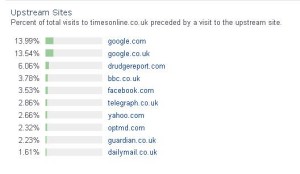[Citation Needed]
![[Citation Needed]](https://www.whencanistop.com/wp-content/uploads/2010/03/C2-A31new.jpg)
This week’s post is going to be slightly different, because I’m going to be doing some investigation. I’m not sure I can count as an investigative journalist, because I’m not a journalist and I don’t really do much investigation, so this is just going to be a one off. This weekend you may or may not have heard that The Times has announced that it is going to be going behind a pay wall as of early May. Those of you who are aware of such things will have noted that I’ve talked about this in the past as I used to work for a publisher:
Well this post is going to be a look at what the effects of The Times moving to a paid content model is. Let me start with the basic in case you didn’t know. If you want to access the site for one day, you are going to have to pay £1. If you want to access the site for a week, you have to pay £2. If you want to just look at the home page, then everything will be free. If you subscribe to the print edition then you get free online access.
It all seems fairly straight forward (although someone may point out that I missing that they are keeping the timesonline site still running with other features – but by the sounds of it they are turning it off).
So this gives us a couple of questions, mainly will they actually make any money? So lets turn it around to a different matter and look at how their current traffic looks. According to a report in the Guardian, The Times got 21.4m unique browsers in January 2010, of which 8m were from the UK. If you want to see their latest figures then you can download them from the ABCe website (ABCe are the industry auditors in this country). From their latest figures, they generated a total of 139,443,741 page impressions in February 2010, of which 74,258,775 were from the UK. Unique browser figures were similar for the two months.
That’s a lot of page impressions.
My past history dictates that a site will try and sell its advertising for about £20 – £45 per thousand (cpm). I would have thought the Times would be on the lower end of that scale. If you want to look at someone who has actually done some research into this (in the States) then there is some useful information at problogger. He sites about $1.5 for a 1,000 impressions. If we were going to be kind and convert that to pounds we could say that timesonline.co.uk could charge £10 per thousand. Assuming they sold all of their UK ads and that they have two ads on every page that would equate to £15m in revenue every month from online advertising. Scary amount really isn’t it? Is that enough to run a business? It seems like it to me. If they are going to get users to pay £8.66 for access to the website every month, they are going to have to generate about 1.7m users actively paying £2 a week every month for the site.
So going back to the 8m UK users they currently get, they are going to have to persuade just over a fifth of them to sign up to their services.
So let us start at the beginning and look at the competitor analysis tools. The most popular of which is Alexa. They say that for the preceding sites, they get about 27% of users coming from Google.com or Google.co.uk:
You can see the US nature of Alexa here – The Times is clearly a UK based website, but here we think that the US version of Google is an upstream site more often. Hitwise, in case you are wondering, says something remarkably similar (obviously with more .co.uk traffic), but obviously it is not publicly available, so I can’t link to it.
I think you can safely assume that when The Times goes behind its paywall all of those visits are going to disappear – Google will not index any pages it cannot crawl and will not promote pages that users can’t get to without subscribing – so you are losing quite a large part of your 8m in one quick shot.
It’s also interesting that The Times appears to get a relatively large volume of traffic from news aggregators – eg the Drudge report and Facebook. These presumably will disappear too at some stage, because aggregators don’t like linking to pages that are behind firewalls. Interestingly from my point of view as well are that the other sites on that list are other news websites. It seems that the Times users don’t only go to one website to read their news – they also look it up on the bbc.co.uk, telegraph.co.uk, guardian.co.uk, dailymail.co.uk. They’re all in the top 10 upstream sites for timesonline.
So how many of the remaining 5.7m user per month are actually going to start visiting the site? Where do they come from. Well they could come from one of the 8.7m inbound links that timeonline.co.uk currently has. Could they come from one of the hundreds of links from the various social bookmarking sites that there are out there (eg Reddit or Digg). You would have thought that this would be quite large.
Maybe they are focussing on their brand traffic. I’m sure I’ve mentioned on here before that a great way of working out how well your brand is doing is to monitor how many times people are searching for your brand name. It’s quite a worrying trend that you can see on Google Trends. They’re not even anywhere close to some of the other big newspapers. In order of fairness, I thought I would do the same graph using the websites options.
The one bit of data that I am really missing is the volume of visits that arrive via RSS feeds, email and/or typing in the URL. Logically speaking these would seem to be the most likely to want to sign up to a subscription model. The trouble is, how are they going to increase the number of people subscribing, when nobody can see what is underneath. These are some of the questions that are going to be answered very soon.
So the questions I still have:
- Will they charge their advertisers more given that they will have more information about the users (registration insists on you telling them your address, for example). This advanced advertising capability based on user demographics would seem to be a great way for them to charge users more and charge advertisers more. I’m assuming that they will still advertisers, of course. This could make up the shortfall in revenue from not as many users signing up to the scheme as they’d hoped. How are the users going to feel about this though?
- Will they be able to persuade enough of their users to sign up and pay given that they are going to lose all of their deep linking.
- Will they do any redirecting of old links to new ones to try and persuade passing traffic to sign up.
- Do they understand that nobody will ever link to them again. This will mean that if they are first with the exclusives, anyone else who writes about it will generate the links upon being asked for [citation needed]
- Will their journalists and columnists be happy to stay at an online publication of, say 1m readers, when they could move to a website of 20m? This is a key one for me, because they will need a USP and ‘news’ won’t be it – everyone can do that. Columnists and journalists should be able to give that added extra to the site, but only if they aren’t enticed away. Breaking news isn’t enough, because it is too easy to replicate elsewhere.
Will Clarkson be happy with a smaller readership?
This seems like it will be a good profit driver in the short term to prop up the newspaper whilst the advertising slows down and everyone works out a proper business model. But in the long term this looks catastrophic. Even if everyone else suddenly decides that they have to go down this route as well, it is a case of the last one standing is the winner. People aren’t just going to give up news, so they’ll either subscribe or they’ll move elsewhere. My study above suggests that they’re probably getting it elsewhere as well at the moment, so they’ll have no incentive to give up their details to Murdoch.
I’m afraid I am going to have to agree with Jeff Jarvis on this one, it does indeed look like Murdoch has surrendered because he doesn’t quite know what to do. Do you have any sources of information that I’ve missed that could help the debate?




Leave a Reply